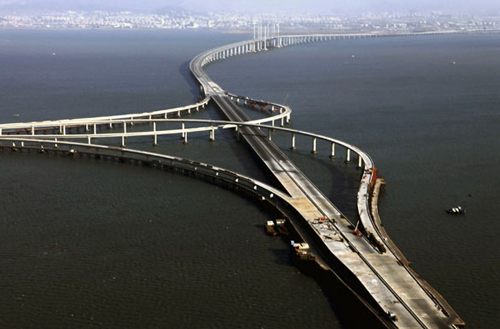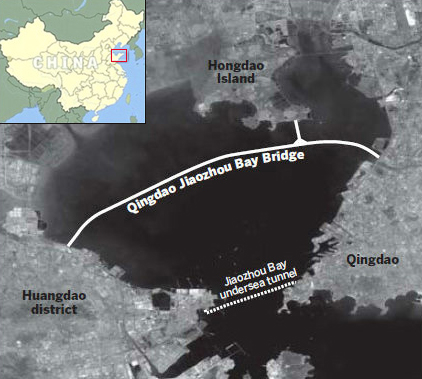
To mark the 90th Anniversary of the founding of the Communist Party two weeks ago, the seaside city of Qingdao in Shandong province opened its new Jiaozhou Bay bridge. At 42.4 km, it is the longest sea bridge in the world. The bridge links historic Qingdao with the city’s industrial zone Huangdao.

On the same day, a 9.47 km undersea tunnel also opened linking the two sides together. As Steve Dickinson of the China Law Blog points out: “The completion of the bridge and tunnel fulfills the long term dream of the Qingdao government to fully integrate the two shores of the Jiaozhou Bay.“
Dickinson goes onto wonder about the possible redundancy of not one but two links across the bay given the high public expenditures of both these projects. At the end of his post, which is titled ‘Qingdao’s New Bridge As Symbol of China Infrastructure‘, he says:
“Nobody is even sure why either the bridge and the tunnel were built, much less the two of them. The bridge seems to be mostly aimed at connection by highway for goods from the ports and airport and tradezones. The tunnel does not provide access to any of this. The high toll for the tunnel means that it will not be used for normal surface transport (private cars and taxis). So why was it built? No one has ever been able to provide me with an explanation. Why was the bridge built at the WIDEST part of the bay? Why was it built when it only provides a 10 minute improvement in travel time? Why was it built with no attention to access and exit? Why were the connecting highways not improved? Who knows.”
Dickinson touches upon what is potentially the most contentious issue about China’s infrastructure: the seldom examined cost/benefit analysis of these new projects. At this point the world knows that China can ‘get it done’ when it comes to building large-scale infrastructure projects. There is no lack of political will or labor to undertake such ambitious plans. Yet lost in the speed of getting these new projects built is a rigorous analysis of the ultimate benefits for what could turn out to be a series of boondoggles.
That is not to suggest that this is not to be expected, especially given that China is a still a developing country. Surely, many of the infrastructure projects will have tremendous benefit now and in the future. I also posit that to some extent China’s leaders are aware of potential labor shortages in the future. As China’s aspiring middle-class urban dwellers move up the value chain, and as the one-child policy begins to take a toll on the country’s youthful demographics, cheap labor will become more scarce.
Given this reality, China appears to be taking an approach that puts speed and ambition above all other considerations, waiting to deal with the details later on. In a sense, this is a cultural phenomenon: creating an environment of rapid growth to ensure social stability and avoid the internal chaos that is still all too near in memory.


by Adam Mayer
Thomas Brizendine - Familiarity with greater Qingdao will clarify city planners thinking with regard to these project. The Bridge not only serves as an immediate industrial link, but opens up vast tracts of 1950s, 60s and 70s industrial areas to redevelopment. Further, premium housing, and commercial (non-industrial) real-estate is clearly along the coast. With the expansion of the Qingdao City administrative area, the tunnel opens up large tracts of area to this type of development. It’s simple. These infrastructure projects make it possible for the local government to continue to fund itself through land deals, and provide performance markers for local cadres.
Adam Nathaniel Mayer - Thanks for the clarification Thomas. It makes sense given that this is the same story of development throughout China. It is the infrastructure that makes available new land for real estate projects…and at this stage in China’s overall development, the local governments cannot survive without auctioning land off to property developers.